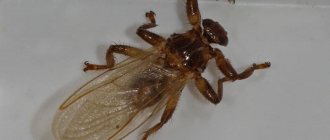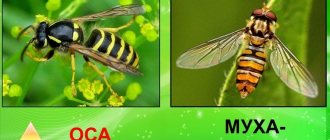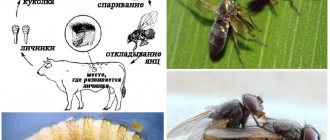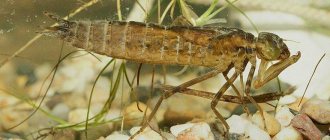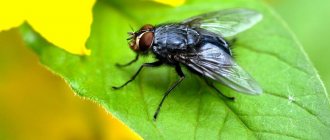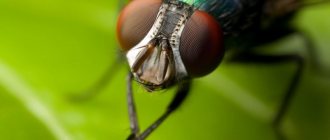We are accustomed to treating flies as an annoying but harmless nuisance. In fact, even the familiar gray and blue flies are not nearly as harmless as they might seem. Even more dangerous are gadflies, which are also large parasitic flies. All these insects cause diseases collectively called “myiases.” The disease occurs when flies lay larvae in a person and the parasites burrow under the skin. Among this group of insects there are few viviparous insects; the rest lay eggs, and the larvae that emerge from the eggs penetrate the skin. Although there are also “viviparous” flies. Sometimes a person organizes myiasis for himself.
Types of myiases and flies that cause diseases
Fly larvae in the human body can be found in the most unexpected places. Most often, myiasis occurs after gadflies lay their eggs. The development cycle of these flies involves development in the body of the host, which can be not only a large animal, but also a person.
On a note!
All videos and photos in which larvae are removed from under the skin refer to infestation by gadflies.
Myiases can be random, facultative and obligate. The type of myiasis largely depends on what flies eat in nature.
Prevention
To prevent the development of myiasis, the following preventive measures must be observed:
- fight flies that appear at home;
- observe the rules of personal hygiene;
- keep the house clean;
- eat only thoroughly washed fruits and vegetables;
- store food correctly (in places inaccessible to insects);
- apply fly repellent;
- promptly treat skin lesions;
- monitor the health of domestic and farm animals, promptly treat skin wounds, and regularly examine for the detection of myiases.
Those who live outside the city need to regularly mow the grass on their property. It is very important that the street toilet, cesspools, and manure heaps are located as far as possible from the house. In order to eliminate the odors emanating from them, which will attract flies, special preparations are used.
Following these rules will help reduce the risk of fly larvae entering the body to zero.
Random
The diseases are caused by flies that usually lay eggs in rotting organic matter. A person becomes infected with these larvae accidentally by ingesting them in food or wearing underwear. For the most part, eggs swallowed by a person are dissolved by gastric juice, but sometimes maggots can penetrate the intestines, causing intestinal myiasis. If a fly lays eggs on wet laundry, the larva can penetrate the urethra, causing genitourinary myiasis.
Occasional cavitary myiases are caused by many flies:
- blue meat (Calliphora vicina);
- indoor (Musca domestica);
- green meat (Lucilla sericata);
- brownie (Muscina stabulans);
- small indoor (Fannia canicularis);
- fruit flies (family Drosophilidae);
- cheese (Piophila casei).
These are not the only, but the main types of flies that infect humans.
Interesting!
A person usually causes intestinal myiasis with cheese fly larvae by eating a dubious delicacy: rotten cheese infected with cheese flies.
Accidental myiasis
Why do they appear?
Most often, myiasis occurs in places where people live in unsanitary conditions, where there is no proper body care, there is no normal medical care, and the population neglects hygiene skills.
In most cases, infection occurs due to the negligence and negligence of people, for example, through contact with contaminated objects, feces, soil, as well as through consumption of food or water contaminated by flies.
Human myiases can be caused by various species of dipteran insects, among them:
- Tumbu flies and sand fleas - their females make passages in the thickness of the skin, which become noticeable in the form of painful thickenings. These insects lay eggs, from which larvae then emerge; sometimes their tips peek out and become accessible for removal with tweezers.
- Tungrate flies - love to infect open, weeping wounds or ulcers on the skin, and also cause tissue and cavity forms of the disease (for example, ocular, oral myiasis).
- Gadflies (Russian and sheep) are the cause of subcutaneous, ocular or oral myiasis.
- Sarcophagids (gray blowflies) and cheese flies – can cause disease in the mouth, nose, intestines or skin.
- Calliphorides - they can cause oral myiasis.
- Small housefly - can infect various organs, causing intestinal, genitourinary, ocular or nasal myiasis.
The larvae of these insects have a high degree of vitality, they are not afraid of chemical reagents (acid and alkaline solutions, ethyl alcohol, formaldehyde) and can live for a long time in the intestines and other cavities of the human body, unsuitable for the habitation of adult individuals.
Intestinal myiasis
In addition to these species, intestinal myiasis can be caused by almost any fly. But this type of disease takes its most serious forms when it is infected by fruit flies and cheese flies.
Symptoms:
- irritation and inflammation of the intestinal mucosa;
- abdominal pain;
- diarrhea with larvae;
- exhaustion;
- sharp pain in the anus;
- vomiting with maggots.
On a note!
Adult maggots reach a length of up to 1.5 cm. Treatment is prescribed after diagnosis and is carried out using anthelmintic drugs against nematodes.
Treatment
Skin myiasis in a person begins to be treated after an examination and an accurate diagnosis by a medical specialist. The diagnosis is determined by careful examination of the lesions in an enlarged format, when the movement of the larvae is noticeable. This usually takes more than one day. For cutaneous myiasis, the destruction of larvae with medications is not used. Surgical extraction is the most effective method.
At the beginning of treatment, the causative agent of the infection is identified, its location is located, after which the parasites are mechanically removed by the doctor. The lesions are cleaned of larvae by washing the wound with disinfectants (potassium permanganate, furatsilin, etc.). For easier extraction, 2-3 drops of sterile oil are used, as a result of which the parasite, being without air, should appear on the surface and can be easily removed. Treatment of the cavity with disinfectants and the presence of an aseptic dressing are required. To prevent purulent complications, antimicrobial ointments or antibiotics can be used.
It is necessary to use drugs for wound healing. It is also important to use intestinal lavage products and take anthelmintic drugs.
For additional treatment at home, you can prepare an ointment using tar, sulfur and petroleum jelly. Proportions – 6 g sulfur, 1 liter of petroleum jelly, 0.5 liter. tar. All ingredients are mixed and used as an ointment for the affected areas once a day.
Important : the main danger of myiasis is the short period of time from the moment of infection until the beginning of the growth of the larva, which quickly takes root in the patient’s body. Sometimes the size of the tumor reaches 5 cm. In some cases, the speed of movement under the skin is up to several tens of centimeters per day.
Urogenital myiasis
After the larvae penetrate the human urethra, severe pain begins in the urinary canal, often with delayed urination. For treatment, the urethra is washed.
This disease can be caused by any type of dipteran insect, but tourists who go on safari to Africa especially often suffer from it. The Congo region is home to the mangrove fly, which lays eggs on damp vertical surfaces.
The local population knows about this feature of the insect and dries clothes by laying them out horizontally. Tourists who do not understand the reason for this custom hang their laundry on clotheslines. And they get cavitary genitourinary myiasis.
Larval development cycle
A fly is an insect with a complete development cycle (complete transformation - holometamorphosis),
which includes the following stages:
- Egg. It takes from 8 to 50 hours to mature, then the formed worm comes out.
- Larva. In the period from 3 to 20 days, fly larvae feed, grow, and molt. After the last molt they turn into a prepupa - the body becomes short and thick. While standing, they find a cool, dry place (they bury themselves in the ground or sand), where they finally pupate. The skin (cuticle) hardens, forming a protective shell - the puparium.
- Doll. A fly is formed inside the puparia within 3-5 days.
- Imago (adult). After 1.5 days, the female is ready for mating.
Under favorable conditions (23-25 ˚C, sufficient food), the fly can live up to 2 months. Larvae, pupae, and fertilized females hibernate at low temperatures, and awaken when warming reaches 10 °C.
Facultative myiases
This group of diseases is caused by flies that normally breed on animal corpses. They cannot lay eggs in a person in the literal sense of the word. Insects lay eggs either in open wounds or on intact skin, ears or nose.
On a note!
Flies do not have an ovipositor that can pierce the skin. Therefore, all photos of a fly laying larvae under the skin are Photoshopped.
The hatched larva itself penetrates the epidermis and develops there for 2-3 weeks. The fully developed maggots leave the body and fall to the ground. There they pupate and after a while adults emerge from the pupae.
Depending on the place where the clutch was made, the larvae penetrate not only under the skin, but also into the eyes, nasal cavities and skull. In this case, the expression “brain eaten” ceases to be figurative. Maggots that have penetrated the cranial cavity feed on brain tissue.
Facultative myiases
If fly larvae get into the eye, they can only be removed surgically. The easiest variant of ophthalmomyasis is the penetration of maggots into the conjunctiva. If it penetrates the eyeball, the disease can result in loss of the organ of vision.
On a note!
In the United States, there have been cases of gray blowfly maggots penetrating deep into the internal tissues of the body.
Removing fly larvae from under the skin, nose and eyes is only possible through surgery.
How does infection occur?
Infection can occur in different ways:
- females lay eggs on human skin, eyes, ears, and wounds.
- sometimes this occurs as a result of a bite - the eggs are injected under the skin
- The larvae may be accidentally ingested, in which case intestinal myiasis may occur.
Based on the method of infection and the type of existence of the insects themselves, human myiases can be divided into the following types:
- random. This type of disease is caused by fly larvae that develop in rotting organic matter. They can accidentally enter the human body through food, dirty laundry, etc. Hence the name. Flies lay eggs everywhere - on clothes, linen, food. The larvae may be ingested during ingestion. Eggs can get into the genitals from underwear.
- obligate. With this type of pathogen, diseases caused by fly larvae occur when they are infected by insect species that lead a parasitic lifestyle. Herbivorous pets can be infected with them. Cutaneous myiasis is most often caused by these types of flies.
- optional. These types of myiasis are accidental, caused by house flies or blow flies, which, attracted by the smell of a purulent wound, can lay larvae in damaged human tissue.
The causative agents of the disease can be the larvae of 18 species of flies, living mainly in the countries of the Southern Hemisphere, but some species are also found in the European part of our continent.
The causative agent of the disease can be the larvae of 18 species of flies
Why do random and facultative myiases occur?
The main cause of these types of disease is common unsanitary conditions. Neglect of personal hygiene and room cleanliness leads to the proliferation of flies, which sooner or later will lay eggs on humans.
Obligate myiases
Caused by flies that initially parasitize warm-blooded organisms. Their other name is gadflies. The reproductive cycle of different individuals may include parasitism of maggots in the stomach, nasal sinuses, or skin.
The gastric botfly attaches eggs to the forelimbs of herbivores. When an animal scratches its leg, it inadvertently ingests eggs, which begin to develop in the gastrointestinal tract. Gastric botfly eggs do not die in the intestines, but humans have little chance of becoming infected with these parasites. The disease is treated with routine deworming of animals. Standard anthelmintic drugs also help a person.
The subcutaneous gadfly usually also attacks large herbivores, laying 1 egg per hair. It does not have a specific point of attachment for the egg. The hatched larva burrows into the skin and begins feeding on the host's flesh. Before moving to the second stage of development, it lays a subcutaneous path to the area of the animal’s back, where it forms a nodule with an opening for air.
The subcutaneous gadfly can lay eggs on humans. In this case, the larvae begin their instinctive upward movement, emerging not on the back, but towards the head of the owner.
Important!
There are known cases of this species penetrating the human brain with fatal consequences.
Subcutaneous myiasis
The main cause of this disease is the larvae of subcutaneous gadflies. Signs of subcutaneous myiasis in humans are red swellings with a hole in the middle. The activity of the larva causes pain to the owner.
Subcutaneous myiasis
To remove parasites, first cover the breathing hole with an airtight bandage. In an attempt to breathe, the larva pokes its head into the hole. A day later, the patch is removed, the emerging larva is grabbed with tweezers and carefully pulled out. This procedure is performed only on humans. The animals' nodules are simply opened.
Nasopharyngeal gadflies
These types of parasites are viviparous. They do not lay eggs, but inject ready-made live larvae into the nostrils, mouth and eyes of animals and humans. Once on the mucous membranes, the parasites invade the victim’s body, causing cavitary myiases in the nose and damage to the eyes and mucous membranes of the mouth. Localization of the offspring of the nasopharyngeal gadfly occurs in the frontal and nasal cavities, pharynx, and ethmoid bone. These same larvae parasitize the mucous membranes of the eyes and mouth and penetrate the eyeballs.
What kind of disease is this
Infection of humans by insect larvae - dermatomyasis is of two types:
superficial - the larvae parasitize on the surface of the skin and do not extend beyond the epidermis.
It can be caused by gadfly larvae; a person can become infected through contact with these animals. The larvae are very mobile, quickly move under the skin, gnawing passages up to 30 cm. The parasite can stay in the human body for up to 2-3 months. Subcutaneous myiasis caused by these parasites is characterized by excruciating itching; the larvae's passages resemble long scratches.
The popular name for the disease is “creeping disease.” Treatment for myiasis is mechanical removal of the parasite.
deep - parasites penetrate under the skin, are located in the deep layers of the epidermis, sometimes this type of lesion becomes tissue
Insects are able to penetrate even healthy skin, and not only as a result of a bite. Sometimes infection occurs even through contact with infected foliage. Many species of flies that can infect humans live in Africa, North and South America, but there are species that are found in Russia, for example, Wohlfahrtia vigil and Wohlfahrtia opaca (Wohlfart fly), various types of sheep and cow gadflies. They are also available in Europe, Pakistan, and North America.
Infestation occurs seasonally, from June to September, with the larvae hatching within 24 hours. Boils appear at the sites where parasites invade. The maturation of the larvae ends on days 12-14, after which they leave the host’s body and pupate.
tissue - the lesion affects soft tissue, this form can occur when flies lay eggs on the edges of wounds, ulcers, wounds, and other damage to the surface of the body.
Cases of the development of larvae in wounds are classified as a separate subtype of the disease - wound. Its danger increases due to the possibility of a secondary infection; in addition, symptoms of fever and severe bleeding from the affected areas develop.
Some species of flies that live in North and South America are capable of laying up to 3,000 eggs even in a small wound, which, when hatched, begin to destroy human tissue and cause serious, deep damage. Insects sense the presence of possible places to lay eggs; even a tiny scratch can attract a female.
Some types of insects are able to penetrate not only damaged skin, but also healthy skin. Symptoms of this are the occurrence of ulcers, boils with severe itching.
Symptoms of insect penetration under the skin are the appearance of ulcers, boils with severe itching
Contact with cattle may cause infection with bovine botfly larvae. At the same time, it is not necessary to touch and stroke the animals - there are cases when a female insect lays eggs on human hair.
The first stage of infection is almost asymptomatic, then slight swelling may appear as the larva moves. A fistula forms at the site where the parasite molts; the usual location is the upper shoulder girdle, head. The larva remains in the fistula until maturity, then leaves the host’s body through the hole and pupates.
The disease is manifested by severe allergic reactions and signs of toxic poisoning of the body (nausea, vomiting, even memory loss). In addition, symptoms occur:
- elevated temperature
- short-term muscle pain
- There may be pain in the heart.
Getting larvae into the eyes is especially dangerous. Insect parasitism in this case can be accompanied by severe pain, swelling of the temporal region, and can lead to decreased and even loss of vision.
Cases of oral myiasis have been observed, when the surface of the oral cavity is affected.
In addition, there have been cases of parasites penetrating the spinal cord and brain. In this case, the mechanism itself has not yet been determined.
Such infection of the human intestines (intestinal myiasis) can occur when eating unwashed vegetables or food that has been left uncovered for a long time.
Some types of flies live in the salty environment of cheese or salted fish and can be eaten.
Severe nausea, vomiting, pain in the stomach - these are the main symptoms of infection by fly larvae. If left untreated, colitis (inflammation of the mucous membrane of the large intestine) may develop. The human intestine may contain housefly, meatfly, and carrion larvae.
What are they?
All myiases are divided into types according to several characteristics - according to the type of larvae, habitat in the host’s body, and the nature of the course of the disease.
Depending on the biological properties of parasitic larvae, they are distinguished:
- facultative types of disease - they occur when infected with the larvae of dipterous insects, which usually do not parasitize the human body, for example, from a blowfly or house fly that has infested food;
- obligate species - these myiases are caused by insects that parasitize exclusively humans and animals (wohlfart fly);
- random species - the causative agents are flies that lay eggs in rotten organic debris; for a person to become ill, he must either swallow contaminated food (intestinal myiasis) or wear underwear contaminated with flies (genitourinary infection).
Depending on the location of the parasite in the human body, the following myiases are distinguished:
- Skin forms of the disease - with superficial lesions, the disease is manifested by the presence of thread-like thickened passages in the epidermis, deeper subcutaneous forms resemble boils in appearance.
- Tissue - larvae corrode tissue in wounds or ulcers on the human body; such myiasis can occupy a large area, and in severe cases provokes the death of the patient.
- Cavitary - parasites settle in the mouth (oral myiasis), nose (nasal myiasis), and genitourinary organs. In the latter case, a person (mostly women) experiences symptoms of vulvovaginitis and cystitis. Oral myiasis is most often observed in children.
- Intestinal forms - develop after ingestion of fly larvae with food (boiled meat, cheese, salted fish). Clinically manifested by symptoms of enteritis (pain around the navel, diarrhea) and colitis (mucus and blood in the stool, frequent false urge to defecate).
- Ocular forms - larvae appearing in the conjunctival sac cause the development of inflammation here such as conjunctivitis, iridocyclitis, and ulcers on the cornea. In difficult situations, they are able to drill into the eyeball and completely destroy it.
Just like nasal and ear myiases, the ocular forms of the disease are dangerous from the point of view of the penetration of parasites into the membranes and substance of the brain.

